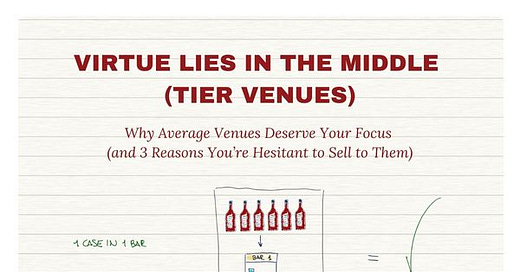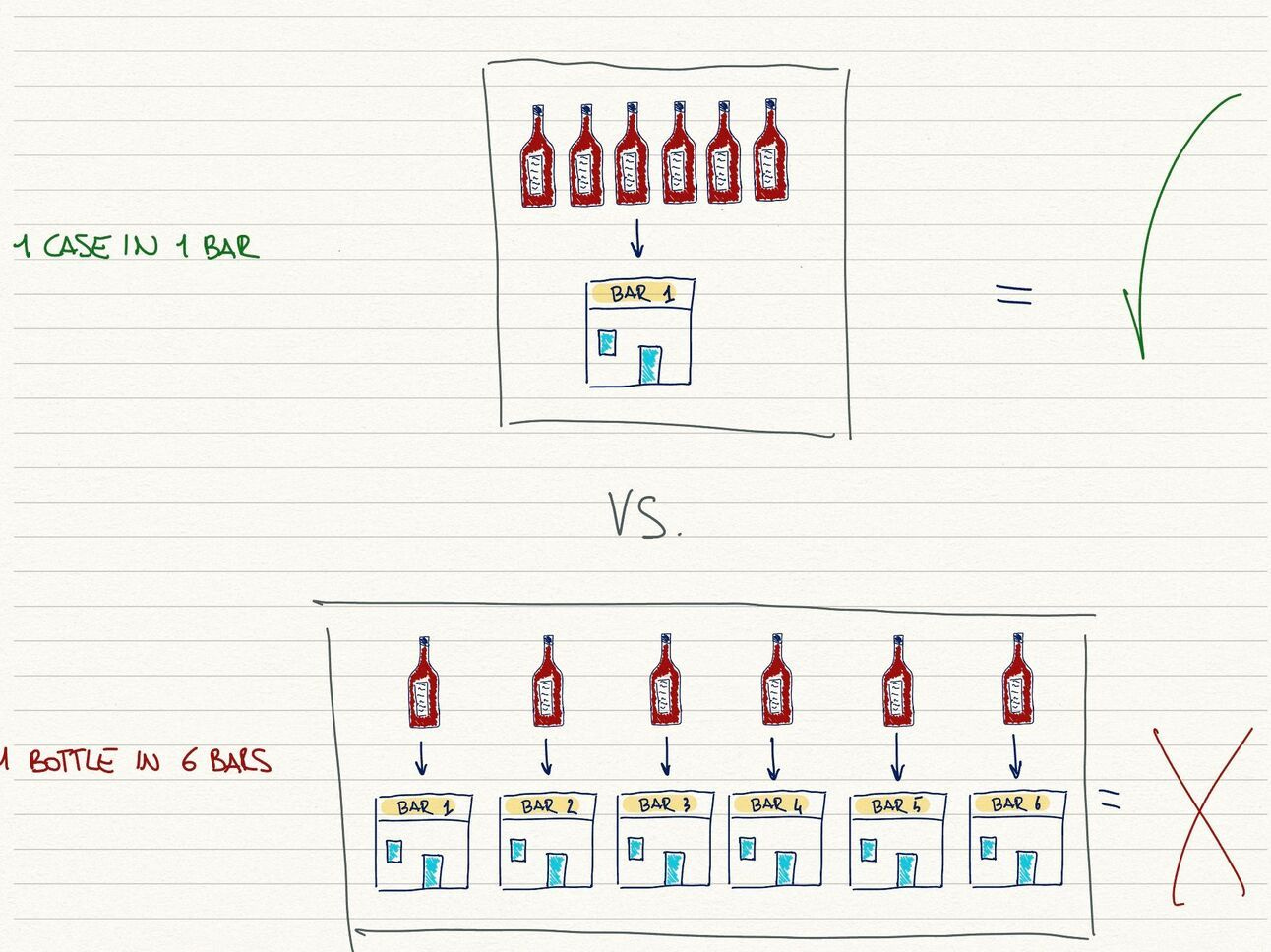Virtue Lies in the Middle (Tier Venues): Why Average Venues Deserve Your Focus (and 3 Reasons You’re Hesitant to Sell to Them)
Let's Debunk This Myths Together
The MAFFEO DRINKS Guides is a bi-weekly email newsletter. With a systematized approach, it helps drink builders grow their brand from 10 to 10k cases. Each edition solves one clear challenge for subscribers. Some editions are free, and others are paid. Sign up here:
Dear Bottom-up Drinks Builder,
In today’s issue, I’ll share my experience and insights into what happens to sales and your brand's P&L when you start selling to more average bars.
By adopting this approach, you’ll spend your time more effectively. You’ll likely increase your distribution while increasing your rate of sale.
Unfortunately, most people think that only cool outlets can build brands. They fear that widening distribution to more standard venues will ruin their brand's image, and they refuse to grasp opportunities. That's a big mistake.
They forget that the consumers who only go to the world's best bars and cool restaurants all the time are just a handful in each city. Most people are normal consumers who want to trade up, enjoy premium products sometimes, and use more mainstream products most days.
Many so-called "premium consumers" visit regular, average bars and look for some trade-up option.
When I started in sales, I made the same mistake. I came from marketing, and I only wanted to focus on cool outlets. I remember not wanting to let my brand be sold in average bars as it would alienate those trendy consumers buying my product.
Of course, every salesperson prefers to hang out in a cool bar than an average one. It's human. But if you get their targets and KPIs right, changing your opinion is easy.
I also soon realized that my brand was growing much slower than it could, and I was sitting on a huge opportunity I had not seen before.
I decided to grow distribution in the outlets that resonated with the brand's commercial proposition and occasion but that were more average. Those outlets wanted the brand, were able to afford it and they were pushing sales to drive their margins.
💡 How to understand the right bar for your brand:
Target Occasion: how does your core occasion fit with theirs? If your occasion is a "shot", a fine dining venue won't be right for you, even if it's on all the guides as the best place in town.
Commercial Proposition: what's your purpose, what values does your brand represent? How would you translate your brand positioning into 3 types of outlets? Those are the outlets where your brand would perfectly fit their drinks range.
It's not about how cool a bar is but about whether the bar to which you "sell in" will manage to "sell out" your product.
The most successful brands are the ones that manage to grow their distribution while also growing their rate of sale. They widen the distribution when they feel there is traction and not only because they have a strong Route-to-market to make it happen.
After their first moves in the market, selling one bottle to one bar, they understood they needed to focus on those bars buying and selling 1 case.
This may sound like a chicken-and-egg dilemma, but it is the secret sauce to growth. This is not only better from a marketing and sales perspective but also from a logistics one. No wholesaler will want to make all those small deliveries, so the more customers you have that sell for a reasonable amount, the better.
What are brand owners' main fears when selling to more average bars?
#1 They can't afford your brand
If they can't afford it, they will not buy it. As long as your wholesaler won't discount it, this will not be a problem. Discounting will only happen if you have pushed your wholesalers to reach some unachievable target for unsustainable growth. They won't discount it for the sake of it, losing margins on it. If you got your targets right, you are fine. Only customers who can afford it will buy it. The key here is to have the right pricing strategy and a good RRP (Recommended Retail Price)
#2 Cool consumers won't like spotting the brand there
If cool consumers will see it there, either they were not that cool or that place was not that bad. Every one of us goes to cool venues when in the mood for it but also visits normal, regular bars all the other times. If you spot a nice brand in a regular venue, it will become a natural trade-up opportunity and drive a healthy rotation. Problem solved.
#3 The brand will not sell out and they'll discount it
This is a worst-case scenario and will rarely happen. Let's be honest: if I owned a bar and was unsure whether it would sell out, I'd probably buy 1 bottle, not 1 case. If I don't manage to sell it, I will drink it myself or offer it to my friends and top clients. Surely, I won't put it on offer. It means my consumers are unsuitable for the brand and I will not rebuy it.
Even better, those friends who tried it for free might even become consumers, and I may buy a new bottle that will sell. Problem solved, either.
TL; DR (Too long, didn't read)👇🏻
Not all cool outlets are the same, nor are all mainstream ones. Focus on the right ones. It's not so much about how cool the outlet is as how it can sell out.
💡 In previous articles, I explored the importance of having a structured system to hunt for new outlets. Check them out here 👇🏻
I hope this mini-guide will help you develop the small, consistent habits you need to build your brand from the ground up.
Whenever you're ready, there are more ways I can help you:
My Digital Course: If you need help TODAY, I get it. I have a solution for you: I’ve captured the most critical aspects of building bottom-up in a 40-minute Self-paced Course: Bootstrapping a Drinks Brand: Dead-Simple Strategies to Avoid 28 Costly Mistakes.
If you’d like to get access to it, click the button below, and I’ll see you on the other side 👇
My Podcast: Join the 1200+ Drinks Builders from 100+ countries that listen to The MAFFEO DRINKS Podcast: every week, a new episode featuring Drinks Builders from around the Globe sharing their learning building Bottom-up.
Remember that our Paid Subscribers here get early releases (one week before everyone else), including episode transcripts, key learning, and deep dives, in their inboxes.
Otherwise, you can anyway listen to it for free on Spotify and Apple Podcasts:
Does this Guide resonate with you? Have you already implemented some of the aspects discussed above? Drop a comment and start the conversation 👇








